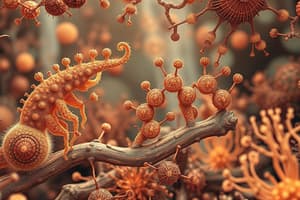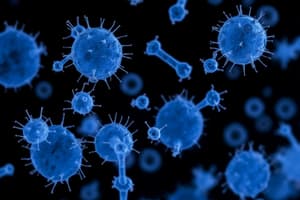Podcast
Questions and Answers
Why does competition inhibit both populations from occupying the same ecological niche?
Why does competition inhibit both populations from occupying the same ecological niche?
- One population wins and eliminates the other due to competitive exclusion. (correct)
- The predators reduce the intensity of competition between prey species.
- The prey species evolve mechanisms to avoid predation.
- The predators keep the prey population in check.
What is the role of predators in maintaining species diversity in a community?
What is the role of predators in maintaining species diversity in a community?
- They ensure stability in the ecosystem.
- They evolve mechanisms to avoid predation.
- They produce inhibitory substances against other microbial populations.
- They reduce the intensity of competition between prey species. (correct)
What is the result of predation on prey population if predators are absent?
What is the result of predation on prey population if predators are absent?
- Prey population will go out of control. (correct)
- Prey population will evolve mechanisms to avoid predation.
- Prey population will produce inhibitory substances.
- There will be stability in the ecosystem.
What is the main consequence of amensalism in microbial ecology?
What is the main consequence of amensalism in microbial ecology?
Which microorganism is mentioned as an example of antibiosis in microbial ecology?
Which microorganism is mentioned as an example of antibiosis in microbial ecology?
Study Notes
Introduction to Environmental Microbiology
- Environmental microbiology is the study of the composition and physiology of microbial communities in the environment (soil, water, air, and sediments, and other artificial environments).
- It concentrates on the application of microbes in resolving environmental problems, such as water and wastewater treatment, biogas production, and solid waste management.
Microbiology
- Microbiology is the discipline that deals with microorganisms, which are living things that cannot be seen with our naked eye.
- Microorganisms can be classified into cellular microbes (bacteria, archaea, fungi, protists) and acellular microbes (viruses and other infectious agents).
- Microbes can be unicellular or multicellular and are fairly simple agents/organisms that are not highly differentiated.
Cellular Structure of Microorganisms
- Flagella (singular flagellum) are appendages that allow bacteria to quickly move towards a point source of nutrients.
- Fimbriae (singular fimbria) are numerous short surface appendages that aid in attachment of cells to surfaces, important for initial colonization and biofilm formation.
- Pili (singular pilus) are longer appendages involved in a mating process, only found in Gram-negative bacteria.
Internal Structure of Microorganisms
- Ribosomes turn mRNA into proteins (translation) and are highly conserved in structure and function.
- Cytoplasm is the gel-like fluid that fills each cell, providing an aqueous environment for chemical reactions.
- DNA (deoxyribonucleic acid) is the genetic material of the cell, containing instructions for the cell's abilities and characteristics.
Microbial Ecology
- Lichens are an example of mutualism between fungi and algae, where algae provide nutrients to fungi and fungi provide water and minerals to algae.
- Microorganisms have different ecological interactions, including commensalistic relationships, competition, predation, and amensalism (antagonism).
- Microorganisms play a crucial role in maintaining ecosystem stability and diversity.
Studying That Suits You
Use AI to generate personalized quizzes and flashcards to suit your learning preferences.
Description
Test your knowledge on the fundamentals of Environmental Microbiology including the biology of microbes, classification of microorganisms, and microbial ecology. This quiz is based on a lecture on Environmental Microbiology by Dr. Tsedekech G/mesekel.




